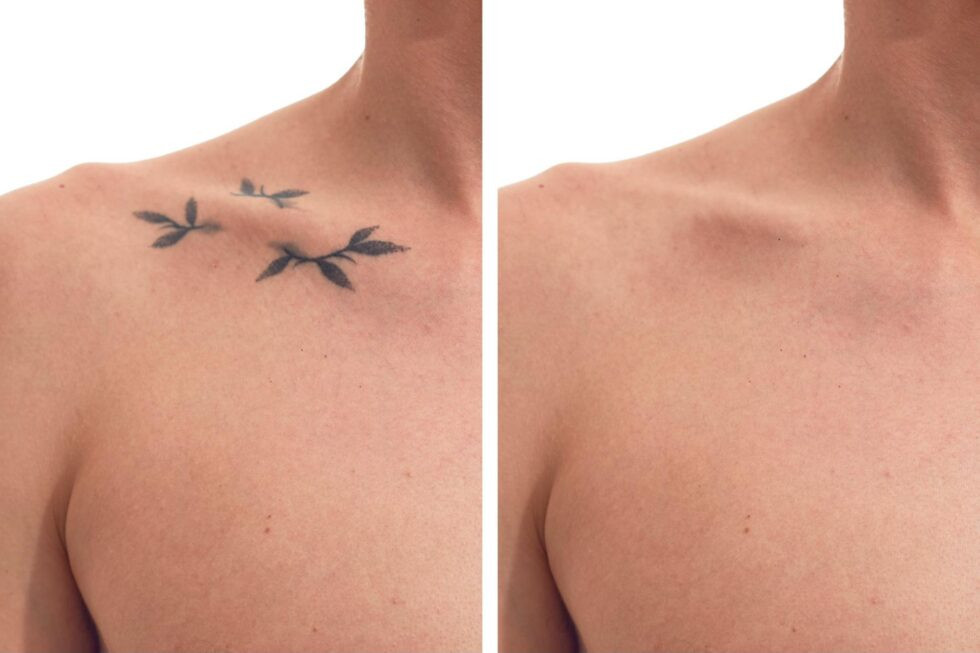Tattoos are a powerful form of self-expression, but as life evolves, so can our feelings about them. For those seeking a fresh start, tattoo removal offers a path to reclaim their skin. Laser tattoo removal has emerged as the gold standard for erasing unwanted ink, yet concerns about Tattoo Removal Scar formation are common. Understanding the factors influencing scarring and adopting proper aftercare are key to achieving the best possible outcome – smooth, ink-free skin.
What Causes Tattoo Removal Scars?
Laser tattoo removal works by directing concentrated light energy at tattoo ink particles beneath the skin. This process breaks down the ink into smaller fragments that the body’s immune system can naturally eliminate. While laser technology is designed to be precise and minimize damage to surrounding tissue, the potential for tattoo removal scar tissue development exists. Several factors can contribute to this:
- Pre-existing Tattoo Scars: The initial tattooing process itself can sometimes result in scarring, especially if the skin experienced trauma or infection during healing. These pre-existing scars will not be removed by laser treatment, though their appearance may improve with skin resurfacing effects of the laser.
- Heat Damage and Thermal Injury: Laser tattoo removal relies on heat to shatter ink particles. If the laser is not used correctly, or if settings are too aggressive for an individual’s skin type, excessive heat can damage the skin, leading to burns and subsequent tattoo removal scar formation. Choosing a qualified and experienced practitioner is crucial to mitigate this risk.
- Neglecting Aftercare Protocols: Proper aftercare is paramount in preventing tattoo removal scar. Failure to keep the treated area clean, moisturized, and protected can increase the risk of infection and impede the natural healing process, potentially resulting in scarring, including hypertrophic or keloid scars in susceptible individuals.
 Close-up of laser tattoo removal process, highlighting the precision of the laser on skin.
Close-up of laser tattoo removal process, highlighting the precision of the laser on skin.
Understanding the Risk of Tattoo Removal Scarring
It’s important to emphasize that significant tattoo removal scar formation is not a typical outcome when laser removal is performed correctly and aftercare instructions are diligently followed. Advances in laser technology, particularly with lasers like Q-switched and Pico lasers, have significantly reduced the risk of adverse skin reactions and scarring. These lasers are designed to target ink pigment specifically, minimizing collateral damage to surrounding skin tissue.
However, individual skin responses vary, and certain factors can increase susceptibility to tattoo removal scar tissue. These include:
- Skin Type and Tone: Individuals with darker skin tones are at a higher risk of hyperpigmentation or hypopigmentation changes post-laser treatment, and may also be more prone to keloid scarring.
- Tattoo Characteristics: Larger, denser tattoos, and tattoos with certain ink colors (especially greens and blues which can sometimes require more aggressive treatment) may necessitate more laser sessions, potentially increasing cumulative skin stress.
- Individual Healing Response: Some individuals naturally heal more slowly or are more prone to scarring due to genetic predispositions or underlying health conditions.
Crucial Aftercare Steps to Minimize Tattoo Removal Scars
Diligent aftercare is your most powerful tool in preventing tattoo removal scar development and ensuring optimal healing. Immediately following each laser session and in the days and weeks after, adhere to these essential aftercare guidelines:
- Gentle Cleansing: Keep the treated area meticulously clean to prevent bacterial infection. Wash gently with mild, unscented soap and lukewarm water twice daily. Pat the area dry with a soft, clean towel – avoid rubbing.
- Consistent Moisturization: Hydration is key to skin repair and minimizing tattoo removal scar risk. Apply a fragrance-free, hypoallergenic moisturizing ointment or cream liberally to the treated area several times a day. This keeps the skin supple, promotes healing, and reduces dryness and scabbing.
- Resist Picking and Scratching: Itching, scabbing, and peeling are normal parts of the tattoo removal healing process. However, picking at scabs or scratching the treated area is strictly prohibited. This can introduce bacteria, disrupt healing, and significantly increase the likelihood of tattoo removal scar formation. Allow scabs to fall off naturally.
- Strict Sun Protection: Laser-treated skin is highly sensitive to UV radiation. Sun exposure can lead to hyperpigmentation (darkening) or hypopigmentation (lightening) of the treated skin, and can also worsen potential tattoo removal scar appearance. Apply a broad-spectrum sunscreen with an SPF of 30 or higher daily, even on cloudy days, and wear protective clothing to shield the treated area from the sun for several months following treatment.
 Close-up of clear skin post tattoo removal, emphasizing smooth texture without scarring.
Close-up of clear skin post tattoo removal, emphasizing smooth texture without scarring.
Proactive Strategies to Minimize Tattoo Removal Scarring
Beyond aftercare, proactive choices can further minimize the risk of tattoo removal scar tissue and enhance your tattoo removal journey:
- Select a Reputable and Experienced Clinic: Choosing a clinic with board-certified dermatologists or experienced laser technicians who specialize in tattoo removal is paramount. Clinics like Metropolis Dermatology utilize advanced laser technologies and have the expertise to tailor treatment parameters to your specific skin type and tattoo characteristics, minimizing risks and maximizing efficacy. This expertise directly contributes to reducing the likelihood of tattoo removal scar tissue.
- Consider Scar-Reducing Products: For individuals concerned about scarring, or those with a history of scarring issues, proactive use of scar-reducing products can be beneficial. Silicone-based gels or sheets are clinically proven to help prevent and improve the appearance of scars. Vitamin E ointments and other topical scar treatments may also be recommended by your dermatologist.
- Explore Skin Resurfacing Options: If you have pre-existing scars from the tattoo process, or if minor textural changes persist after laser tattoo removal, skin resurfacing treatments can be considered. Procedures like laser resurfacing or chemical peels can stimulate collagen production and improve the overall texture and appearance of the skin, further minimizing the visibility of any potential tattoo removal scar.
Achieving Smooth, Clear Skin with Expert Tattoo Removal
While the prospect of tattoo removal scar tissue can be a concern, it’s important to remember that with the right approach, the risk is low and manageable. Choosing a qualified provider, understanding the process, and diligently following aftercare instructions are the cornerstones of successful, scar-minimized tattoo removal.
At Metropolis Dermatology, our commitment is to provide safe, effective, and scar-conscious tattoo removal using the latest laser technologies and personalized treatment plans. Our experienced team in Los Angeles, Pasadena, LA’s Westside (Brentwood), Costa Mesa, and San Jose, CA, is dedicated to guiding you through every step, ensuring a comfortable experience and helping you achieve the clear, smooth skin you desire.
Ready to begin your journey to ink-free skin? Schedule a consultation with Metropolis Dermatology today and take the first step towards reclaiming your skin’s natural beauty, without the worry of unwanted tattoo removal scar tissue.
